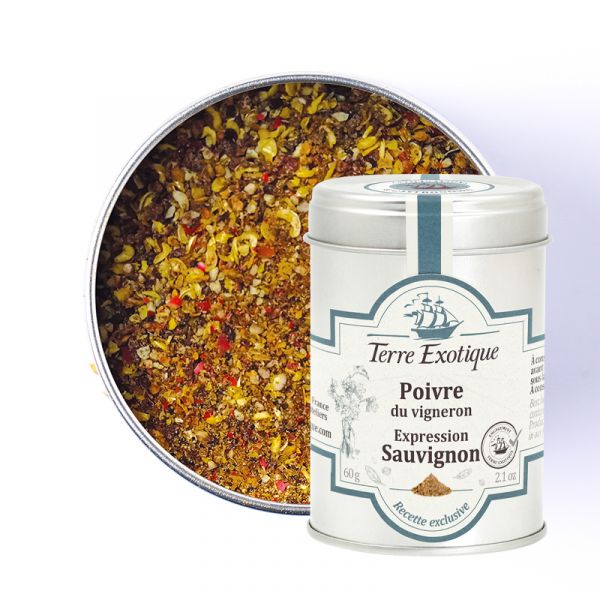
How to Use Winemaker's Pepper, Sauvignon Expression?
In a perpetual quest for new flavors, Terre Exotique has imagined an innovative blend of peppers and berries, echoing the Sauvignon grape variety for a true connection between the plate and the glass.
How to Use Winemaker's Pepper, Sauvignon Expression?
Here are some recipe ideas to incorporate Winemaker's Pepper, Sauvignon Expression into your cuisine:
· Traditional Asparagus à la Flamande: Before serving, sprinkle ½ teaspoon of Winemaker's Pepper, Sauvignon Expression on your plates (find the complete recipe below);
· Potato Gratin: Before baking your gratin, sprinkle 1 teaspoon of Winemaker's Pepper, Sauvignon Expression on top;
· Homemade Mayonnaise with Winemaker's Pepper: Add ½ teaspoon of Winemaker's Pepper, Sauvignon Expression to your mayonnaise before whipping. Ideal for enhancing the flavors of a seafood platter;
· Baked Trout: Sprinkle 3 pinches of Winemaker's Pepper, Sauvignon Expression on your trout before baking;
· Flambéed Prawns with Cognac: Once flambéed, add 3 pinches of Winemaker's Pepper, Sauvignon Expression to your prawns.
Discover the recipe for Mackerel Rillettes with Winemaker's Pepper, Sauvignon Expression
Aromas of Winemaker's Pepper, Sauvignon Expression
This blend of peppers and berries has fruity notes of pineapple and exotic fruits, as well as vegetal notes of fresh mint. In the mouth, there is an animal and spicy character of menthol and thuja. Overall, it perfectly captures the aromas of the famous Sauvignon grape variety.
The Botany of an Astonishing Blend
What is Winemaker's Pepper, Sauvignon Expression Composed Of?
The winemaker's blend is made up of Malabar black pepper, cubeb pepper, Kampot red pepper, Batak berries, and Penja white pepper.
The Peppers in This Blend
The cultivation of pepper originates from the Malabar coast in India. Malabar Black Pepper takes its name from the Sanskrit (Indo-European language): "Pippali". Harvested at optimal maturity, this pepper, with its great freshness, harmonizes perfectly with red meat, sweet and savory preparations, or vegetable tarts.
Cubeb Pepper is obtained from berries harvested before maturity, dried, and ground. You can consume it directly by chewing the berry. This small peppercorn grows mainly in Southwest India, between Sumatra, Java, or Borneo. Cubeb pepper, whose botanical name is Piper cubeba L., grows wild in the middle of the tropical forest. Its harvesting requires a lot of meticulousness and lasts about a month. Indeed, the plant develops by wrapping itself around trees that can grow up to more than 10 meters high.
Kampot Pepper belongs to the species Piper nigrum, a pepper genus also found in India, Cameroon, and Southeast Asia. The seeds of this pepper grow on a vine that can grow several meters high. For several months, the vine grows and produces bunches. When the berries turn red, it means they are at optimal maturity. The bunches are then harvested without delay to prevent rotting. In Kampot, the red berries are soaked in boiling water and then in ice water immediately after being harvested. This is followed by several days of drying in shade and sun to fix the aromas and red color of the pepper. The berries are then sorted and calibrated to keep only the most beautiful ones.
Penja White Pepper is also derived from Piper nigrum, a giant vine. It grows on a tree with rough and cracked bark that facilitates its ascent, often up to four meters high. Its pollination is done by rain, frequent in the Moungo region. In Cameroon, the land is volcanic, rich, and fertile, which allows Penja pepper to be very concentrated in essential oils and aromas.
Batak berries are also called "Andaliman Pepper" or "Batak Pepper." They are picked in the wild north of the island of Sumatra in Indonesia by the ethnic group of the same name, also called the "Toba people." They come from a thorny shrub: Zanthoxylum acanthopodium (a cousin of the shrub producing Szechuan berries) growing at 1500 m above sea level, north of Tapanuli and Samosir, near Lake Toba. This region is nicknamed "the kingdom of the Bataks." The Batak are recognized in Indonesia for their qualities as musicians, their great speaking abilities, their architecture, and their constant questioning of Indonesian authorities. They live in communities in regions bordering Lake Toba.
How Terre Exotique Imagined Winemaker's Peppers?
Linking Glass to Plate, A Challenge Masterfully Achieved!
The winemaker's pepper blends, imagined in collaboration with a chef sommelier, are to be used at your leisure, to accompany a wine of the same grape variety, to educate your nose to the aromas of the grape variety in question, or simply to reproduce the aromatic notes of the grape variety in a culinary creation.
This collection consists of 3 other blends, each capturing the aromas of a grape variety:
Winemaker's Pepper, Cabernet Expression
Winemaker's Pepper, Gamay Expression Winemaker's Pepper, Chenin Expression The appreciation of the aromatic restitution of the grape variety offered by these blends varies like a good wine, depending on each person's palate: all you have to do is try them to find out! Learn more about winemaker's peppers and tasting tipsWinemaker's Pepper is available in the custom-made set dedicated to peppers from around the world
| Allergen | Absence |
|---|---|
| Native country | FRANCE |
| Ingredients | black pepper, cubebe pepper, Kampot pepper red PGI, batak berry, |
| white Penja pepper PGI. | |
| TRACES EVENTUELLES D'ALLERGÈNES | céleri, sésame, moutarde, fruits à coques. |
 Français
Français 




